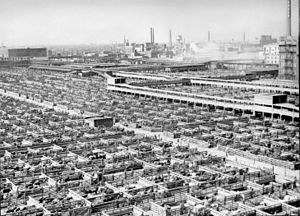
The Union Stock Yard & Transit Co., or The Yards, was the meatpacking district in Chicago for more than a century, starting in 1865. The district was operated by a group of railroad companies that acquired marshland and turned it into a centralized processing area. By the 1890s, the railroad capital behind the Union Stockyards was Vanderbilt money.[1] The Union Stockyards operated in the New City community area for 106 years,[2] helping Chicago become known as the "hog butcher for the world," the center of the American meatpacking industry for decades.[3] The yards became inspiration for literature and social reform.
The stockyards became the focal point of the rise of some of the earliest international companies. These refined industrial innovations and influenced financial markets. Both the rise and fall of the district reflect the evolution of transportation services and technology in America. The stockyards have become an integral part of the popular culture of Chicago's history. They are considered one of the chief drivers that empowered the animal–industrial complex into its modern form.[4][5]
From the Civil War until the 1920s and peaking in 1924, more meat was processed in Chicago than in any other place in the world.[6] Construction began in June 1865 with an opening on Christmas Day in 1865. The Yards closed at midnight on Friday, July 30, 1971, after several decades of decline during the decentralization of the meatpacking industry. The Union Stock Yard Gate was designated a Chicago Landmark on February 24, 1972,[7] and a National Historic Landmark on May 29, 1981.[8][9]
- ^ J'Nell L. Pate, Livestock Hotels: America's Historic Stockyards (Texas Christian University Press: Fort Worth, Texas, 2005) p. 79.
- ^ Pacyga, Dominic (2005). "Union Stock Yard". Chicago Historical Society. Archived from the original on February 19, 2007. Retrieved March 7, 2007.
- ^ Sandburg, Carl (1916). "1. Chicago". Bartleby.com. Archived from the original on March 27, 2009. Retrieved June 15, 2009.
- ^ Sorenson, John (2014). Critical Animal Studies: Thinking the Unthinkable. Toronto, Ontario, Canada: Canadian Scholars' Press. pp. 299–300. ISBN 978-1-55130-563-9. Archived from the original on October 23, 2021. Retrieved October 7, 2018.
- ^ Nibert, David (2011). "Origins and Consequences of the Animal Industrial Complex". In Steven Best; Richard Kahn; Anthony J. Nocella II; Peter McLaren (eds.). The Global Industrial Complex: Systems of Domination. Rowman & Littlefield. p. 200. ISBN 978-0739136980.
- ^ Wade, Louise Carroll (2004). Grossman, James R.; Ann Durkin Keating; Janice L. Ruff (eds.). Meatpacking. University of Chicago Press. ISBN 0-226-31015-9. Archived from the original on May 20, 2009. Retrieved June 15, 2009.
{{cite book}}:|work=ignored (help) - ^ "Chicago Landmarks". Chicago Landmarks. Archived from the original on February 3, 2007. Retrieved March 6, 2007.
- ^ "National Historic Landmarks Survey: Listing of National Historic Landmarks by State: Illinois" (PDF). Archived (PDF) from the original on February 28, 2011. Retrieved March 7, 2007.
- ^ "Old Stone Gate, Chicago Union Stockyards". National Park Service. Archived from the original on May 28, 2008. Retrieved March 30, 2007.
© MMXXIII Rich X Search. We shall prevail. All rights reserved. Rich X Search
